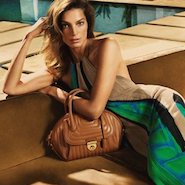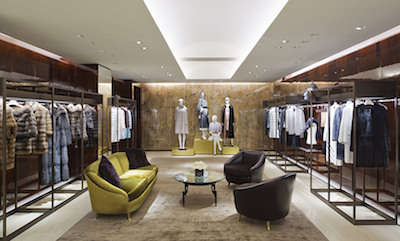- About
- Subscribe Now
- New York,
February 12, 2015

 Ferragamo spring/summer 2015 ad campaign; luxury industry insiders have a sunny outlook for 2015
Ferragamo spring/summer 2015 ad campaign; luxury industry insiders have a sunny outlook for 2015
With renewed levels of optimism in the luxury industry, 90 percent of marketers are planning expansions this year, according to a new report from Wealth-X.
Those in the luxury sector are generally positive about the outlook for this year, with 92 percent believing their total revenues will be up in 2015, with 50 percent expecting at least a 10 percent growth in revenue. Compared with other sectors, hospitality and service professionals were most likely to have expansion plans, focusing on new products, ramping up digital efforts and opening new stores.
"There’s a backdrop of optimism from a macro perspective, because of this continued growth in the equity markets," said David Friedman, president of Wealth-X, New York.
"That kind of wealth effect becomes self-fulfilling, making people feel greater optimism, and when they do that, it’s the spirit that drives more luxury spending, which then creates better financial results for luxury, and then the markets go up, and it’s this virtuous cycle," he said.
For its Luxury Sentiment Survey Report Q1 2015, Wealth-X sent a survey to more than 1,000 luxury brands across sectors, including clothing, shoes and leather; watches and jewelry; household furnishings; electronics; spirits and wines; antique, art and collectibles; hospitality and services; planes and helicopters; yachting and boating and motor vehicles. Respondents, who replied between Jan. 13-24, typically oversee multiple regions in their positions.
Looking up
According to its latest survey, Wealth-X’s Luxury Industry Sentiment Index sits at 100.6. While slightly lower than pre-holiday’s 108.2, it is about equivalent to the first quarter of 2014, when it was 100 even.
Respondents are more optimistic about the entirety of 2015, than they are about the first quarter. For instance, 64 percent believe they will increase their ultra-high-net-worth clients in the first three months, compared to 75 percent who anticipate the same for the whole year.
Wealth-X map of UHNW individuals
Eighty-four percent of those surveyed think their UHNW market share will increase throughout the year, and only 2 percent expect a decrease in market share.
UNHW clients are important to marketers of luxury goods, with 61 percent of respondents saying at least 75 percent of their business comes from these individuals. Fifty percent say they are not expecting to alter the portion of their marketing budget aimed at these consumers, most likely because 65 percent already use more than half of their funds to reach these individuals.
For the 90 percent with expansion plans, the most common effort is new products, with 43 percent planning launches for the first quarter. Other initiatives include new store openings—planned by 16 percent—and increasing a digital presence, part of yearly plans for 35 percent.

New Fendi store on Madison Avenue
Despite respondents overseeing a number of global regions, there was a consensus pointing to the importance of the United States market. Thirty-six percent say the majority of their clients come from the United States, not surprising since it holds the most UHNW individuals of any country.
"A lot of the luxury brands are retrenching to focus on the U.S. market," Mr. Friedman said. "The new mantra I’ve been hearing is the U.S. is the new emerging market for luxury
"With the clampdown in China on exhibiting in luxury, if you’re part of the party, you’ve gone from Mercedes benz to a Passat."
As a result, luxury brands are focusing in on markets that were previously untapped by most luxury goods, including Texas and Chicago, a city which has the ninth largest population of UHNW individuals.
Even with the feeling of optimism, some challenges still remain, with competition the most common concern. This is followed by decreased demand, lack of inventory and personnel issues.
Better together
The majority of luxury marketers have used affinity partnerships as a tactic to reach affluent consumers, but only 47 percent say they see a higher ROI from these type of efforts compared to those without these relationships.
Those targeting ultra-high-net-worth individuals for big ticket purchases, such as yachts or automobiles, were the least likely to forge these connections, with 37 percent saying that affinity marketing is not a strategy they use. Alternative luxury, including art and spirits, were most likely to use these tactics, with 88 percent using these partnerships to reach an UHNW audience.
Eighty-two percent of those who do use affinity partnerships use them to create targeted, bespoke events. The next most popular use was devising exclusive products. For instance, Hublot created themed timepieces surrounding American football team the Dallas Cowboys (see story).
"I think that luxury brands are recognizing, especially when you’re trying to engage or connect with the ultra-affluent, that you have to go in through some avenue or channel that has interests or is important to them," Mr. Friedman said. "They’re immune to the traditional forms of marketing and advertising, it just doesn’t work.
"The other philosophical aspect to affinity marketing is how the luxury brands are actually giving the ability to their targeted ultra affluent prospect, they’re giving them the opportunity to place themselves at the center of their brand narrative and then re-narrate that brand’s story with them at the center of the story, with them at the center by going through their affinities," he said. "It’s the tip of the spear into how you can enter into their attention."
Hublot for Dallas Cowboys
While there is a general feeling that ROI is not raised with these partners, 78 percent say these strategic connections help them expand their customer base, and 68 percent believe that these alliances boost their brand’s prestige. Other benefits include a reduced cost of hosting an event, help with venue selection and access to a larger guest list.
However, 95 percent admitted there are risks to these partnerships, including the potential for incompatibility, increased competition and the chance of appearing too broad.
Respondents say they choose affiliates based on their experience, potential for future collaborations, expertise in the same or a different industry and their compatibility in branding.
When reaching out to a partner, only 20 percent use cold calling to begin a collaboration. Instead, the majority relies on a prior relationship or a referral to create a new strategic bond.
Affinity partnerships are typically lengthy affiliations, with 53 percent focused on collaborations for at least a year. Luxury brands also tend to keep their partnerships slim, with 61 percent only having one or two alliances at a time.
Most, 78 percent, anticipate increasing their use of affinity marketing in the future.
Luxury brands and retailers can benefit more from joining together, according to panelists at Luxury Retail Summit: Holiday Focus 2014 in September.
For both established and start-up retailers, being part of a larger luxury community comes with perks, including access, protection and awareness building. Independent brands may want to think of finding strategic partnerships for support (see story).
"One revolution is the ability to do affinity clustering from a data perspective around your prospects and clients, so when you do create a marketing budget, you actually are tracking against a population. Today what they often do is a wine event or a culinary event and they try to shoehorn and invite people, whether those people have an affinity for that or not.
Affinity marketing is still a long way away from what they need to be able to actually leverage it to get the right people in the room. But at least it hints at the fact that they recognize these are where these individuals are.
"Brands make assumptions that if you’re at an art festival, you’re going to be ultra-high-net-worth, so they say 'We’re going to have an art strategy," he said.." Or we think that these affluent individuals congregate at polo matches, so we’re going to sponsor a polo match.
"But what they don’t do is start with their target individuals or clients and see what they really do like in terms of passions, hobbies and interests, and then create a strategy around that.
"Most luxury brands are doing it the wrong way."
Final Take
Sarah Jones, editorial assistant on Luxury Daily, New York
Share your thoughts. Click here